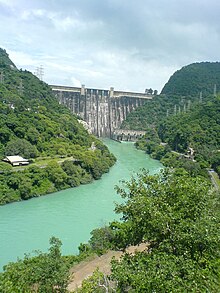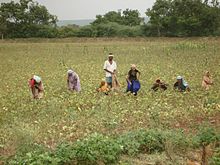HISTORY OF AGRICULTURE IN INDIA(Wikipedia)
Republic of India (1947 CE onwards)
Special programmes were undertaken to improve food and cash crops supply.[42] The Grow More Food Campaign (1940s) and the Integrated Production Programme (1950s) focused on food and cash crops supply respectively.[42] Five-year plans of India—oriented towards agricultural development—soon followed.[42] Land reclamation, land development, mechanisation, electrification, use of chemicals—fertilisers in particular, and development of agriculture oriented 'package approach' of taking a set of actions instead of promoting single aspect soon followed under government supervision.[43] The many 'production revolutions' initiated from 1960s onwards included Green Revolution in India, Yellow Revolution (oilseed: 1986-1990), Operation Flood (dairy: 1970-1996), and Blue Revolution (fishing: 1973-2002) etc.[44] Following the economic reforms of 1991, significant growth was registered in the agricultural sector, which was by now benefiting from the earlier reforms and the newer innovations of Agro-processing and Biotechnology.[45][46]
Due to the growth and prosperity that followed India's economic reforms a strong middle class emerged as the main consumer of fruits, dairy, fish, meat and vegetables—a marked shift from the earlier staple based consumption.[47] Since 1991, changing consumption patterns led to a 'revolution' in 'high value' agriculture while the need for cereals is experienced a decline.[47] The per capita consumption of cereals declined from 192 to 152 kilograms from 1977 to 1999 while the consumption of fruits increased by 553 %, vegetables by 167 %, dairy products by 105 %, and non-vegetarian products by 85 % in India's rural areas alone.[48] Urban areas experienced a similar increase.[48]
Agricultural exports continued to grow at well over 10.1 % annually through the 1990s.[49] Contract farming—which requires the farmers to produce crops for a company under contract—and high value agricultural product increased.[50] Contract farming led to a decrease in transaction costs while the contract farmers made more profit compared to the non-contract workforce.[51] However, small landholding continued to create problems for India's farmers as the limited land resulted in limited produce and limited profits.[49]
The 1991 reforms also contributed to a rise in suicides by indebted farmers in India following crop failures (e.g. Bt cotton). Various studies identify the important factors as the withdrawal of government support, insufficient or risky credit systems, the difficulty of farming semi-arid regions, poor agricultural income, absence of alternative income opportunities, a downturn in the urban economy which forced non-farmers into farming, and the absence of suitable counseling services.[52][53][54]
Since independence, India has become one of the largest producers of wheat, edible oil, potato, spices, rubber, tea, fishing, fruits, and vegetables in the world.[55] The Ministry of Agriculture oversees activities relating to agriculture in India. Various institutions for agriculture related research in India were organised under the Indian Council of Agricultural Research (est. 1929). Other organisations such as theNational Dairy Development Board (est. 1965), and National Bank for Agriculture and Rural Development (est. 1982) aided the formation of cooperatives and improved financing.
The contribution of agriculture in employing India's male workforce declined from 75.9 % in 1961 to 60 % in 1999–2000.[56] Dev (2006) holds that 'there were about 45 million agricultural labor households in the country in 1999–2000.'[57] These households recorded the highest incidence of poverty in India from 1993 to 2000.[58] The green revolution introduced high yielding varieties of crops which also increased the usage of fertilisers and pesticides.[59] About 90 % of the pesticide usage in India is accounted for by DDT andLindane (BHC/HCH).[60] There has been a shift to organic agriculture particularly for exported commodities.[61]
During 2003-04, agriculture accounted for 22 % of India's GDP and employed 58 per cent of the country's workforce.[62] India is the world's largest producer of milk, fruits, cashew nuts, coconuts, ginger, turmeric, banana, sapota, pulses, and black pepper.[62] India is the second largest producer of groundnut, wheat, vegetables, sugar andhjjgyugcy fish in the world.[62] India is also the third largest producer of tobacco and rice, the fourth largest producer of coarse grains, the fifth largest producer of eggs, and the seventh largest producer of meat.[62]



No comments:
Post a Comment